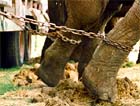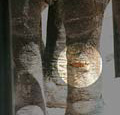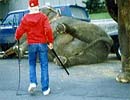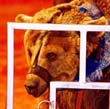CRUELTY TO ANIMALS
In the wild, bears donít ride bicycles, tigers
donít jump through fiery hoops, and elephants donít stand upright on their hind
legs. Circuses portray a distorted view of wildlife.
Laws protecting animals in traveling shows are inadequate and poorly enforced.
The Animal Welfare Act establishes only minimum guidelines and even these meager
standards are often ignored.
Animals used in circuses live a dismal life of domination, confinement, and
violent training. It is standard practice to beat, shock, and whip them to make
them perform ridiculous tricks that they cannot comprehend.
Most elephants used by circuses were captured in the wild. Once removed from
their families and natural habitat, their lives consist of little more than
chains and intimidation. Baby elephants born in breeding farms are torn from
their mothers, tied with ropes, and kept in isolation until they learn to fear
their trainers.
Big cats, bears, and primates are forced to eat, drink, sleep, defecate, and
urinate in the same cramped cages.
Elephants often suffer crippling injuries from constant chaining and performing
physically difficult tricks.
Children, who are naturally fond of animals, would have to be dragged kicking
and screaming to the circus if they knew of the suffering these animals endure
for a fleeting moment of so- called amusement.
The circus deprives animals of their basic needs to exercise, roam, socialize,
forage, and play. Stereotypic behaviors such as swaying back and forth,
head-bobbing, pacing, bar-biting, and self-mutilation are common signs of mental
distress.
Using dangerous animals in performances jeopardizes public safety and often puts
children at greatest risk. Since 1990, 57 people have been killed and more than
120 seriously injured by captive elephants.
Animals in circuses are hauled around the country in poorly ventilated trailers
and boxcars for up to 50 weeks a year in all kinds of extreme weather
conditions. Access to the basic necessities of food, water, and veterinary care
is often inadequate.
A growing number of cities are restricting or banning the use of animals in
entertainment. More progressive circuses dazzle their audiences solely with
skilled human performers.
 Chains
Chains Baby
elephants born in breeding compounds are prematurely removed from their
mothers for training. During the separation process, calves are kept isolated
and tied with ropes at the front leg and back leg. Rope burns may develop as
they struggle against the restraints.
Baby
elephants born in breeding compounds are prematurely removed from their
mothers for training. During the separation process, calves are kept isolated
and tied with ropes at the front leg and back leg. Rope burns may develop as
they struggle against the restraints. ankus, has a long
handle and a sharp metal hook, and it's used to discipline elephants. Although
an elephantís skin is thick, it is sensitive enough for them to feel the pain
of an insect bite. Trainers embed the hook into the soft tissue behind the
ears and inside the mouth or tender spots under the chin and around the feet.
Click here for more
information on the bullhook.
ankus, has a long
handle and a sharp metal hook, and it's used to discipline elephants. Although
an elephantís skin is thick, it is sensitive enough for them to feel the pain
of an insect bite. Trainers embed the hook into the soft tissue behind the
ears and inside the mouth or tender spots under the chin and around the feet.
Click here for more
information on the bullhook. Whips
Whips![]()
